Classroom Security AND Classroom Safety – Why Compromise?
[Click here to download the article reprint.]
There is additional information about this topic, including statements from organizations and individuals, on this blog post.
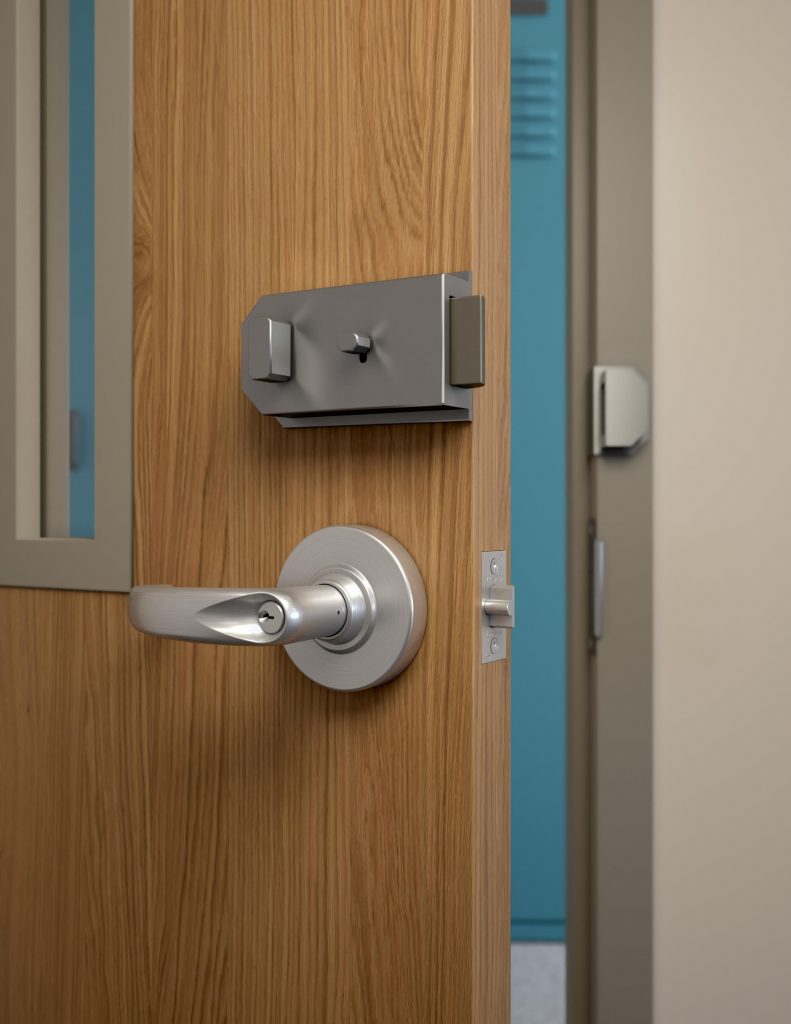
The proposed change to NFPA 101 which would apply to existing buildings in certain occupancies does not prohibit two simultaneous releasing operations, and does not require classroom door hardware to be operable with no tight grasping, pinching, or twisting of the wrist.
Several proposed changes regarding classroom security are currently being considered for the 2018 edition of NFPA 101 – The Life Safety Code. There is one proposed change – just one little word, actually – that is a major deviation from the current model codes and is inconsistent with both the International Building Code and International Fire Code:
“The releasing mechanism shall open the door leaf with not more than two releasing operations.”
This proposed language would apply only to existing buildings and would not affect new buildings at this time, but it’s possible that this change could be used as justification for a future proposal that would affect all buildings. For the 2018 edition of NFPA 101, there are three occupancy chapters where this language regarding two operations would be inserted: Chapter 15 – Existing Educational Occupancies, Chapter 17 – Existing Day Care Occupancies, and Chapter 39 – Existing Business Occupancies.
Many college and university classroom buildings are considered business occupancies, so the proposal for Chapter 39 would include classroom doors within these facilities. Unfortunately, because the proposal for this chapter does not specifically reference classrooms or colleges/universities, the language could actually be applied to any room in any business occupancy with approval from the Authority Having Jurisdiction (AHJ).
This language would allow building owners to request the AHJ’s permission to use retrofit security devices in any existing business occupancy. NFPA 101’s definition of a business occupancy and the examples listed in Annex A include city halls, courthouses, outpatient clinics, town halls, and office buildings, in addition to college and university classrooms. This could put AHJs in a tough position, similar to the situation in some states where school districts have pushed for AHJs to allow classroom barricade devices in schools.
Given the changes in construction and code requirements over the years, it could be very difficult and time-consuming for an AHJ to evaluate an existing building to determine whether two releasing operations should be allowed on the egress doors. The presence or lack of active and passive fire protection features could affect this decision. It seems that an existing building without the currently-required safety features should have egress doors that are easier to use, not more difficult.
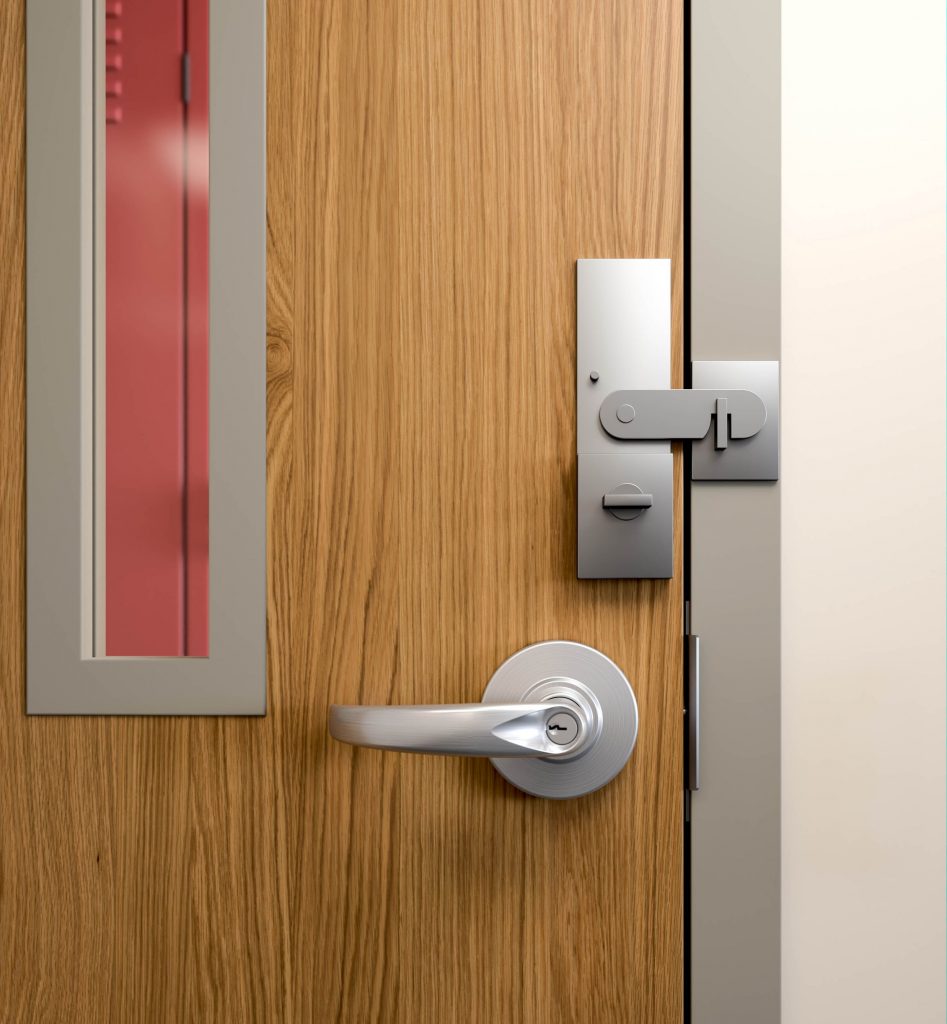
Unfamiliar security devices that could be permissible under the proposed change might be confusing for users to operate, particularly in conjunction with existing latching hardware. Products that have not been tested or certified may not operate as expected when installed in a high-use / high-abuse location.
More is Not Always Better
When reviewing the proposed change to NFPA 101-2018, one should begin by considering the current one-operation requirement versus the proposed two-operation limit for existing buildings. Would increasing the number of operations that must be performed to open a door actually enhance the level of safety in our classrooms? Does the potential for increased security justify delaying occupants’ evacuation? What is the motivation behind this change, and does it outweigh the potentially deadly consequences?
The Life Safety Code has required hardware to unlatch with one releasing operation for almost 30 years. Even as far back as the 1927 edition of the Building Exits Code, doors were required to be “so arranged as to be readily opened.” Similar language still exists in the Life Safety Code today. It seems obvious that a door that requires one releasing operation would be more readily openable than a door that requires two or more releasing operations.
The mere presence of two releasing devices would make the door unusual and could potentially require special knowledge and effort to unlatch. Perhaps the locks need to be released or removed in a specific order. Maybe there is confusion about whether the lock is currently in the locked or unlocked position. The releasing hardware on an egress door is supposed to be intuitive – valuable time could be lost attempting to operate a door that is not. And what happens while someone is trying to release the latches and other occupants are also attempting to evacuate? Will the releasing mechanisms still operate when there is pressure against the door? Are the products required to be tested and certified to operate under these conditions?
The 1985 edition of NFPA 101 required a simple type of releasing device such as a knob, handle, or panic bar, with a method of operation that is obvious, even in the dark. In the 1988 edition, a line was added to quantify the allowable number of operations: “Doors shall be openable with no more than one releasing operation,” with an exception for one additional releasing operation on dwelling units in residential occupancies. The requirement for one releasing operation has been included in the ten editions of the Life Safety Code that have been published since 1988.
Sacrificing Life Safety for Cost Savings
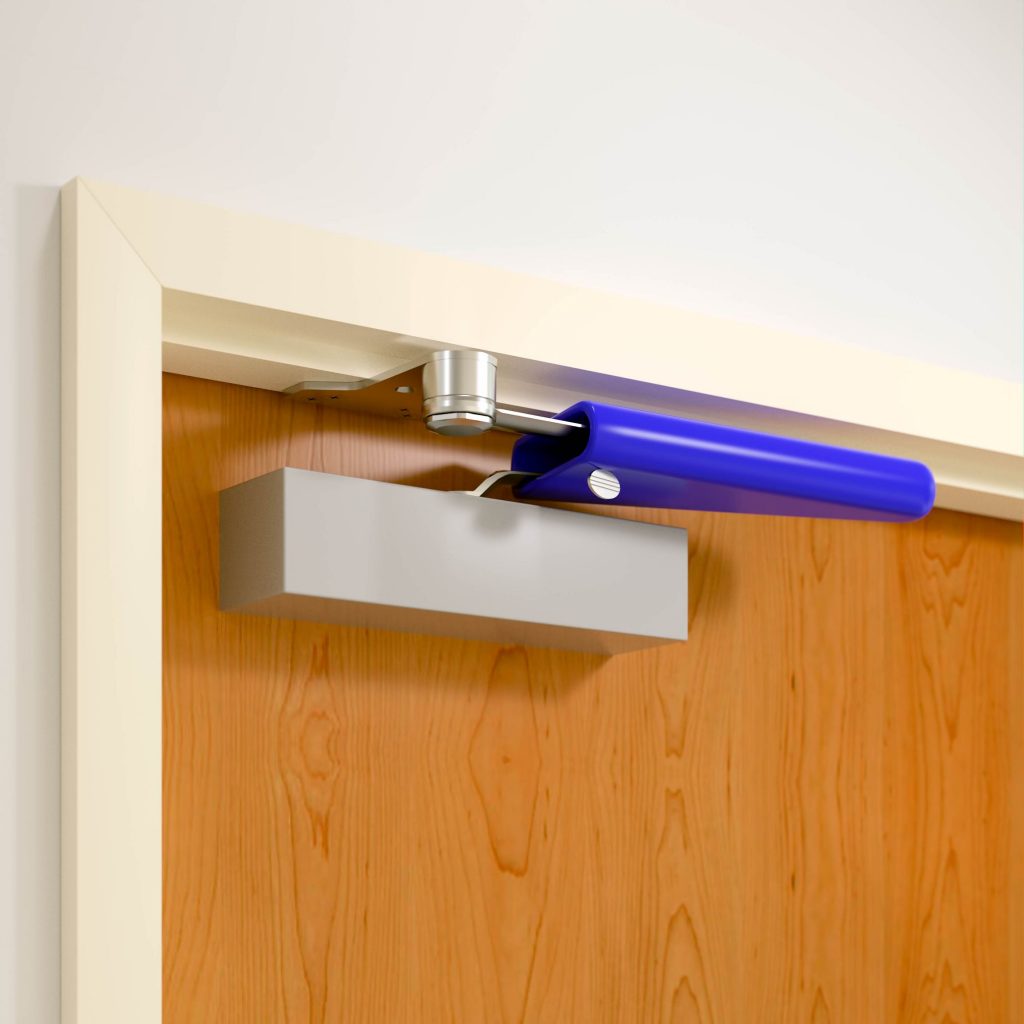
The proposed NFPA 101 language does not allow security devices which modify the door closer, panic hardware, or fire exit hardware.
So why change now? There is no shortage of code-compliant products available to provide the necessary level of security for any of these occupancies. Even in areas prone to vandalism and theft, there are a variety of ultra-secure products designed for use on exterior doors which release with one operation. If code-compliant security products exist that can be used to protect our classrooms, and the model codes are being strengthened to ensure safety as well as security, what is motivating the change to two operations instead of one?
It’s possible that the proposed change is a response to the demand for retrofit security devices that do not comply with the current model code requirements. In response to the many school shootings and other school-related incidents in the US, there has been a heightened focus on school security. However, rather than addressing the existing locks, key systems, glazing, and security procedures that may not provide a sufficient level of protection, some school districts have elected to install retrofit security products, also known as classroom barricade devices. As mentioned previously, AHJs in many states came under tremendous pressure to approve these products, despite clear violations of the existing model codes. One unfortunate example occurred in Arkansas, where the State Senate voted unanimously to amend the fire code requirements and allow the use of barricade devices despite the strong objections of their state fire marshal, who also happens to be a top law enforcement official.
The end result of these politically-motivated changes has been a number of inconsistencies from one state to the next, and even greater variations between school districts where conditional use of retrofit security devices is allowed. First responders could arrive on-scene without knowing what to expect and without the tools needed to access rooms equipped with classroom barricade devices. In addition to impacting evacuation, these devices could also be used by someone intent upon barricading the door to commit a crime or take hostages, delaying response by staff or law enforcement.

If the change is approved, devices used to secure classroom doors would have to be able to be unlocked from the outside using a key or approved credential.
While it may be relatively inexpensive to purchase and install barricade devices on classroom doors, in some cases it may actually cost less to simply address the existing doors and hardware. The locks might need to be rekeyed and keys distributed to all staff members. Existing glazing can be addressed with security film to delay access through a sidelight or vision light. New protocols, like keeping existing classroom function locksets locked during the school day, could also enhance existing security at a relatively low cost, without creating potential threats to occupants’ life safety.
Safety vs. Security
The model codes do allow two releasing operations for the entrance door to a dwelling unit or sleeping unit. This exception seems reasonable, as the person who is disengaging the locks for egress is probably the same person who engaged the locks and is likely to be very familiar with the method required to do so. However, a young student attempting to remove a retrofit security device in order to evacuate a classroom may not know how to disengage an unfamiliar locking device that was installed by the teacher.
NFPA 101 also currently allows two releasing operations for existing hardware on a door that is serving a room with an occupant load of 3 people or less. Obviously, the occupant load of an average classroom is well over 3 occupants. It hardly seems reasonable to raise the limitation from 3 occupants to 30 or more, especially when most of those occupants are children.
Under the stress of an emergency situation, the average person struggles to correctly perform just one fine motor skill. This point was also made by Joseph Hendry, CLEE, who has decades of experience in law enforcement and who now works for the ALICE Training Institute, training civilians to proactively handle the threat of an aggressive intruder or active shooter event. “Several assumptions are being made without considering that most people are unable to perform one fine motor skill under stress,” he said. “Requiring them to perform two is probably beyond 90-95% of the people I see in training.” He went on to note that even highly-trained law enforcement officers miss 70-80% of rounds fired under stressful situations.
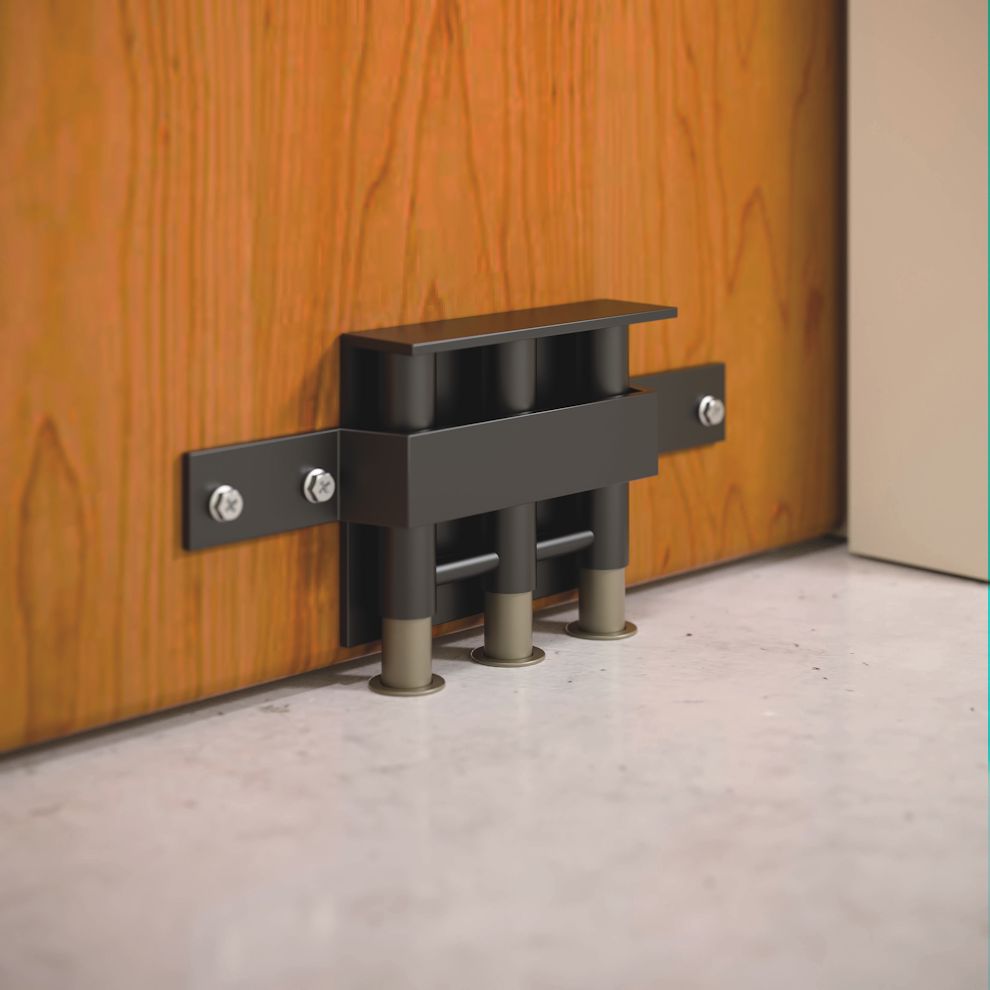
Consistent with the current model code requirements, the releasing hardware for classroom doors must be mounted between 34 inches and 48 inches above the floor.
Another issue that is apparently being overlooked is the fact that classroom doors are not exempt from the federal and/or state accessibility requirements that apply to doors on an accessible route. These standards require hardware to be operable with one hand, and with no tight grasping, pinching, or twisting of the wrist; the proposed change to NFPA 101 does not include these requirements, and is therefore inconsistent with the accessibility standards. It should also be noted that there is nothing in the proposed language to prevent the two releasing operations from having to be performed simultaneously. This type of operation could restrict egress for many occupants under normal conditions, and could seriously impact evacuation under the stress of an emergency situation. To ensure that classroom doors are usable by everyone, the accessibility standards must apply at all times, particularly in the event of an emergency.
When preparing for the possibility of an intruder in school, the focus on security often overshadows accessibility concerns. Is a school emergency plan even required to meet the accessibility standards? According to the Guide for Developing High Quality School Emergency Operations Plans, plans must comply with the Americans With Disabilities Act (ADA), among other prohibitions on disability discrimination. This guide is a joint publication of the US Department of Education, the US Department of Health and Human Services, the US Department of Homeland Security, the US Department of Justice, the Federal Bureau of Investigation (FBI), and the Federal Emergency Management Agency (FEMA).
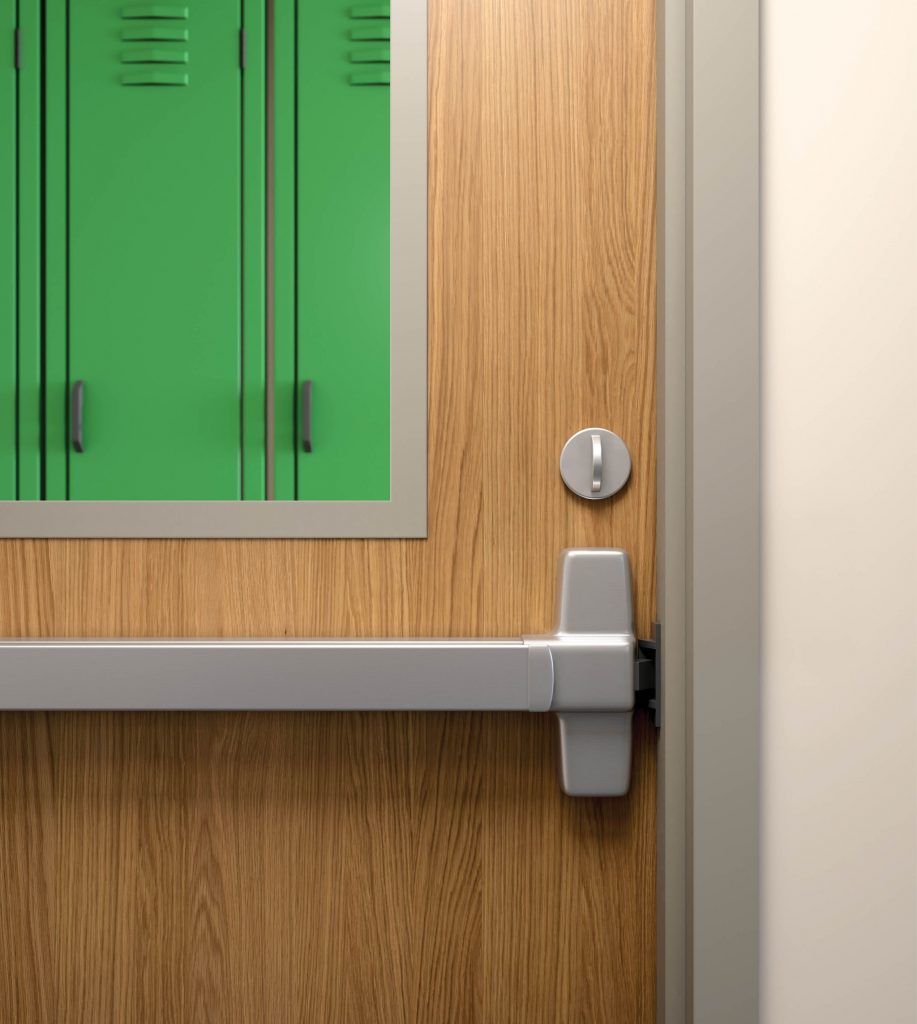
Although the Life Safety Code prohibits additional locking devices to be installed on a door that is equipped with panic hardware, it’s unclear whether the proposed code change would override this limitation for classroom doors.
“A Hazard to Occupants”
In order for NFPA 101 to allow two releasing operations for certain egress doors, an exception would need to be added in Chapter 7 – Means of Egress, referencing the applicable occupancy chapters. Chapter 7 of NFPA 101 currently requires doors to be openable with one releasing operation, and the Technical Committee on Means of Egress – a different committee than those considering the proposed language for the occupancy chapters – is opposed to the addition of the new language in Chapter 7.
The committee stated that increasing the number of releasing operations is “dangerous and could create a hazard to occupants.” They went on to note that there is existing technology that meets the current code requirements and that allowing multiple operations “is contrary to decades of experience resulting in fatalities in schools and other buildings.”
Many of our existing codes were developed in response to tragedies like the fires at the Triangle Shirtwaist Factory, the Iroquois Theater, or the Cocoanut Grove Nightclub – situations where people died because they were unable to evacuate quickly and safely during an emergency. We have worked for decades to ensure that life safety is maintained, first and foremost, in any building. It’s the reason chains and padlocks aren’t allowed on exit doors, despite how inexpensive and effective those chains are at preventing unauthorized access. After so many years of steadily improving life safety and successfully reducing the number of fatalities due to structure fires, I can see no justification to change the Life Safety Code in a way that could reverse those gains.
Joseph Hendry raised similar concerns, noting, “I find it hard to believe that no human-subject testing is being conducted before considering the change from one releasing operation to two. Allowing something so far beyond the pale – without studying human response to stress – is unconscionable in the use of retrofit security devices. The mistakes we made with lockdown are being exacerbated by the push for these devices.”
It’s Not Too Late
Fortunately the proposed changes to NFPA 101 have not yet received final approval, and some of the points will be discussed in June at the National Fire Protection Association’s annual Technical Meeting. Eligible NFPA voting members will have the opportunity to vote Wednesday, June 7, 2017 during the Technical Meeting in Boston, to establish the final language that will be included in the 2018 edition of NFPA 101.
Given the concerns related to evacuation and accessibility, the inconsistencies with other model codes and standards, the non-specific language around business occupancies, and the lack of evidence establishing that the new language would not be detrimental to life safety, I hope the voters will carefully consider their decision and vote to maintain that crucial balance between safety and security.
Note: The change proposals can be found on pages 31, 36, and 79 of this document, and the response from the Technical Committee on Means of Egress is on page 6 of 13 in this report. The classroom security language that has been approved for the 2018 IBC is here, and the 2018 IFC language is here. Both of these code changes require classroom doors to unlatch with one operation, as required by the current model codes.
~~~
Although some proponents of classroom barricade devices have advocated for a reduction in fire safety in favor of increased security, the statistics illustrate the need for continued focus on life safety:
Active Shooter Incidents – 2000-2013:
- 160 incidents
- 487 deaths
- 557 injuries
Source: FBI Study of Active Shooter Incidents in the United States Between 2000 and 2013
Non-Residential Structure Fires – 2000-2013:
- 1,456,500 fires
- 1,260 civilian deaths
- 21,560 civilian injuries
Source: National Fire Protection Association (NFPA) – Non-Residential Structure Fires

